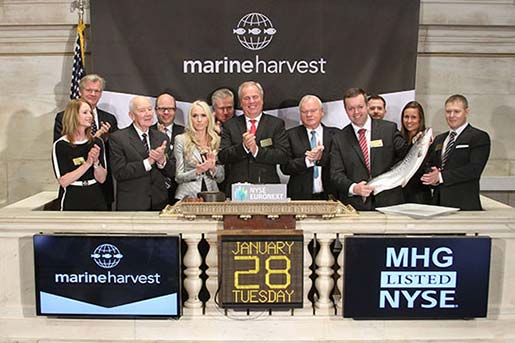Posting earnings before interest and taxes (EBIT) of EUR 259 million in the fourth quarter of 2016, up from EUR 90 million in Q4 of 2015, Marine Harvest issued a quarterly dividend of NOK 2.80 per share to stockholders on February 15.
 Over six million meals of from Marine Harvest farmed salmon and other seafood products supplied by the company are consumed around the world every day. “Driven by high salmon prices on strong demand and reduced supply, we achieved record high operational results in the fourth quarter. It is very encouraging to see strong operational performance in all our entities,” said Alf-Helge Aarskog, chief executive officer of the Bergen, Norway-headquartered company.
Over six million meals of from Marine Harvest farmed salmon and other seafood products supplied by the company are consumed around the world every day. “Driven by high salmon prices on strong demand and reduced supply, we achieved record high operational results in the fourth quarter. It is very encouraging to see strong operational performance in all our entities,” said Alf-Helge Aarskog, chief executive officer of the Bergen, Norway-headquartered company.
Marine Harvest also achieved an all-time high operational EBIT for the full year at EUR 700 million, compared to EUR 347 million in 2015. The company, which ranks as the world’s largest producer of farmed salmon, reported operational revenues of EUR 1,018 million in Q4, up significantly from EUR 867 million in the fourth quarter of 2016.
Total harvest volume weighed in at 99, 634 tons during the quarter, down from 110,551 in 2015. Harvest guidance for 2017 is 403,000 tons, which is in line with the previous guidance.
Sales of salmon of Norwegian origin logged an operational EBIT per kilo of EUR 2.70 in Q4 (compared to EUR 1.47 the previous year), while salmon of Scottish and Canadian origin generated operational EBIT per kilo of EUR 1.83 and EUR 3.33, respectively (vs. EUR -0.30 and EUR 0.36 in 2015). Chilean origin salmon achieved operational EBIT per kilo of EUR 2.61 in the quarter (vs. EUR -1.31 the year before).
MH Consumer Products recorded an operational EBIT of EUR 22.9 million (vs. EUR 9.8 million in 2015). MH Feed reported an operational EBIT of EUR 10.8 million (vs. EUR 8.0 million).
“We continue to strengthen the efforts in North America, with the new Dallas (Texas) plant opening at the end of the fourth quarter and a new value-added facility opening in British Columbia by the end of the second quarter of 2017,” said Aarskog. “Marine Harvest is also nominated to purchase farming assets on the East Coast of Canada, which in the future can further strengthen our supply to the North American market.”
Farewell New York
Meanwhile, Marine Harvest intends to terminate its New York Stock Exchange (NYSE) listing and deregister under the US Securities and Exchange Act of 1934. In the future MHG shares will be listed exclusively on the Oslo Stock Exchange.
 After ceremoniously joining the New York Stock Exchange in January of 2014, Marine Harvest has decided to delist shares from the “Big Board,” reportedly due to low volume. Soon they will again be traded exclusively on the Oslo Stock Exchange.
After ceremoniously joining the New York Stock Exchange in January of 2014, Marine Harvest has decided to delist shares from the “Big Board,” reportedly due to low volume. Soon they will again be traded exclusively on the Oslo Stock Exchange.
Noting that only three percent of Marine Harvest’s worldwide stock trading occurred in the United States during the past year, and that the costs of maintaining a NYSE listing and a registration under the Exchange Act are significant, the company decided that it is in the best interest of shareholders to discontinue the listing and terminate reporting obligations in the US.
“The delisting and deregistration will enable us to simplify financial reporting processes, while maintaining the same high-quality IFRS compliant financial reporting and disclosures, said Marine Harvest Chief Financial Officer Ivan Vindheim. “Corporate governance will not be affected, as important governance bodies such as the board audit committee will remain, in addition to an adequate level of internal controls. We will also maintain the same strong focus on serving our US investor base as we have had in the past.”
Following the delisting and deregistration, Marine Harvest will continue to be subject to the rules of the Oslo Stock Exchange and other Norwegian and European Union financial market regulations.





